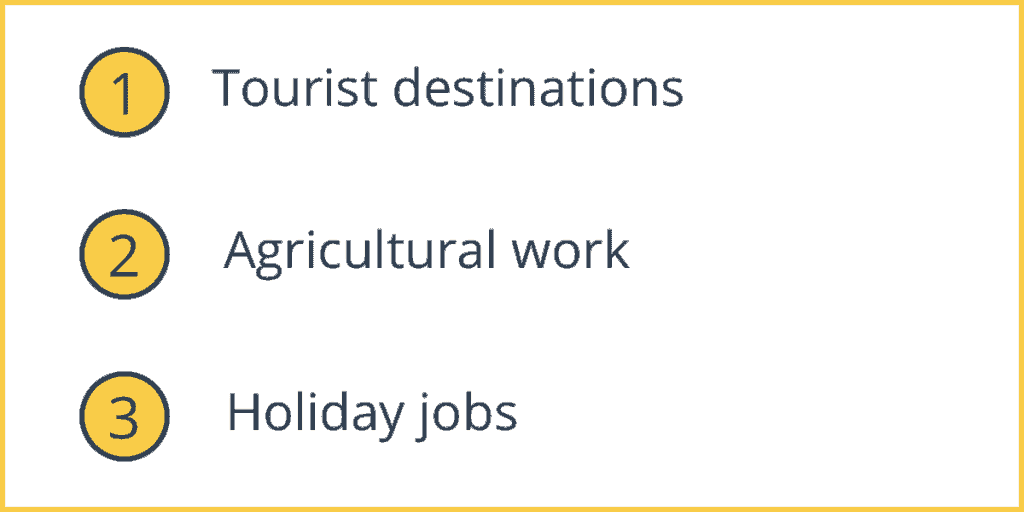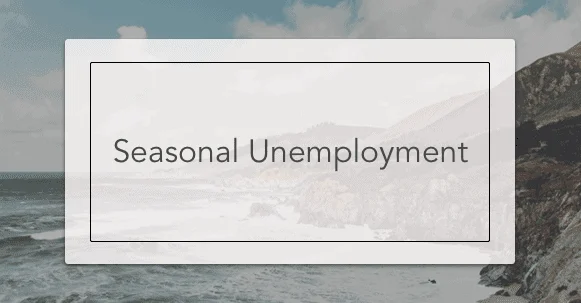The concept of seasonal unemployment describes a situation when workers experience unemployment at certain times of the year when the demand has decreased. Although unemployment is always problematic, the upside is that seasonal unemployment doesn’t last–eventually, the peak season of a given industry arrives and many workers become employed once again.
Many workers adapt to seasonal unemployment by working quite a bit when demand is high and saving up much of their earnings, then living off of those savings during their seasons of unemployment.
Seasonal Unemployment Examples

Here are three notable examples of seasonal unemployment.
1. Tourist destinations
Seasonal unemployment is an especially significant issue in tourist destinations, where the economy is primarily dependent on tourism. For instance, some tourist destinations are attractions primarily for their beautiful, sunny beaches. If there’s a time of year when the beaches are cold and rainy, people won’t want to come to visit during that season. Resorts won’t have any reason to have workers (e.g. housekeepers) stay on, and therefore workers will become unemployed during that rainy part of the year when demand is low.
2. Agricultural work
Another common example is that of many kinds of agricultural jobs. Many crops are only grown and harvested at certain points of the year. During the crop’s off-season, farmers’ hired workers will not have any work to do and will, therefore, experience seasonal unemployment at that time.
3. Holiday jobs
A third well-known example: jobs that are linked to the holidays. Some jobs are only relevant during the holiday season, e.g. being a Christmas tree seller or a retail worker at holiday-related pop-up shops. Since there is so much more retail taking place during the holiday season, workers will be hired during this time, but then will become unemployed as demand decreases when the holiday season ends.
Pros and Cons of Seasonal Unemployment
Pros:
- It is not as harmful as standard unemployment, because workers are being paid for part of the year. Many people rely on it for their income.
- Although unemployment is never really positive, seasonal unemployment is fairly predictable as it happens on a seasonal schedule.
- When workers are not employed, they can focus on building their skills in other areas–for instance, they might seek out an internship or an apprenticeship that will make them more employable.
- For some people, seasonal unemployment is beneficial for their schedule and allows them to focus on other things (jobs, personal obligations, interests, etc.) during the part of the year when they’re not working.
Cons:
- Overall, workers are likely to earn less money for the whole year, since they are not working for part of the year. This is, of course, the most significant issue with seasonal unemployment.
- Production decreases on seasonal products–customers who have a demand for seasonal goods and services cannot access them at any time in the year. This is a problem with seasonal markets in general.
Data on Seasonal Employment in the United States
As of June 2018, the national seasonal unemployment rate for the entirety of the United States was 3.8 percent (source).
Here are examples of some rates across various states (note that the availability of recent data varies widely):
- Colorado: 2.3 percent in April 2017 (source)
- Virginia: 2.9 percent as of September 2018 (source)
- Minnesota: 3.1 percent in February 2019 (source)
- Kansas: 3.3 percent in July 2019 (source)
- Missouri: 3.6 percent as of June 2018 (source)
- Hawaii: 6.4 percent in 2010 (source)
Seasonal Demand for Commodities
Notably, along with seasonal unemployment, there is often seasonal under-use of raw materials used in production. For example, there will most likely be a seasonal peak in the production of warm, waterproof boots during the winter, as there is more demand for such products to protect from cold weather.
Thus, there will be a winter increase and a summer decrease in demand for both rubber (used to construct the boots) and workers (who will actually make the boots).

